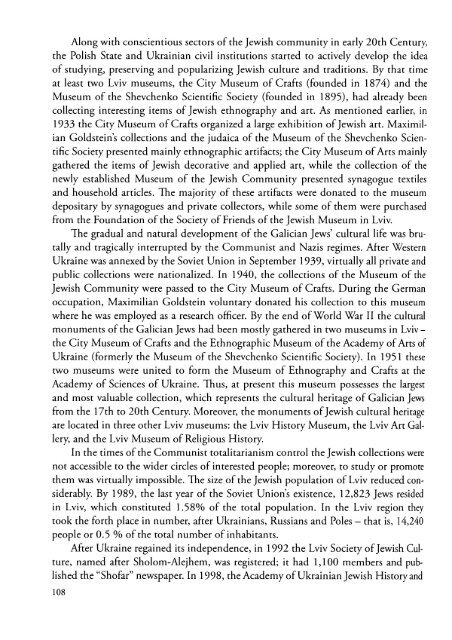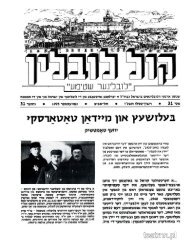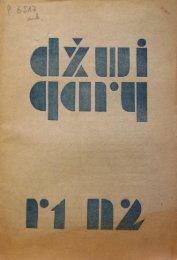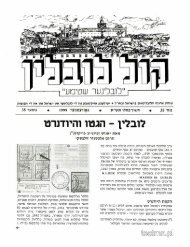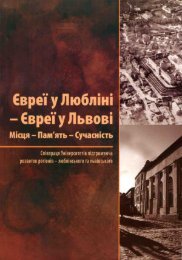The Jews in Lublin - Biblioteka Multimedialna Teatrnn.pl - Brama ...
The Jews in Lublin - Biblioteka Multimedialna Teatrnn.pl - Brama ...
The Jews in Lublin - Biblioteka Multimedialna Teatrnn.pl - Brama ...
Create successful ePaper yourself
Turn your PDF publications into a flip-book with our unique Google optimized e-Paper software.
Along with conscientious sectors of the Jewish community <strong>in</strong> early 20th Century,<br />
the Polish State and Ukra<strong>in</strong>ian civil <strong>in</strong>stitutions started to actively develop the idea<br />
of study<strong>in</strong>g, preserv<strong>in</strong>g and populariz<strong>in</strong>g Jewish culture and traditions. By that time<br />
at least two Lviv museums, the City Museum of Crafts (founded <strong>in</strong> 1874) and the<br />
Museum of the Shevchenko Scientific Society (founded <strong>in</strong> 1895), had already been<br />
collect<strong>in</strong>g <strong>in</strong>terest<strong>in</strong>g items of Jewish ethnography and art. As mentioned earlier, <strong>in</strong><br />
1933 the City Museum of Crafts organized a large exhibition of Jewish art. Maximilian<br />
Goldste<strong>in</strong>s collections and the judaica of the Museum of the Shevchenko Scientific<br />
Society presented ma<strong>in</strong>ly ethnographic artifacts; the City Museum of Arts ma<strong>in</strong>ly<br />
gathered the items of Jewish decorative and ap<strong>pl</strong>ied art, while the collection of the<br />
newly established Museum of the Jewish Community presented synagogue textiles<br />
and household articles. <strong>The</strong> majority of these artifacts were donated to the museum<br />
depositary by synagogues and private collectors, while some of them were purchased<br />
from the Foundation of the Society of Friends of the Jewish Museum <strong>in</strong> Lviv.<br />
<strong>The</strong> gradual and natural development of the Galician <strong>Jews</strong>' cultural life was brutally<br />
and tragically <strong>in</strong>terrupted by the Communist and Nazis regimes. After Western<br />
Ukra<strong>in</strong>e was annexed by the Soviet Union <strong>in</strong> September 1939, virtually all private and<br />
public collections were nationalized. In 1940, the collections of the Museum of the<br />
Jewish Community were passed to the City Museum of Crafts. Dur<strong>in</strong>g the German<br />
occupation, Maximilian Goldste<strong>in</strong> voluntary donated his collection to this museum<br />
where he was em<strong>pl</strong>oyed as a research officer. By the end of World War II the cultural<br />
monuments of the Galician <strong>Jews</strong> had been mostly gathered <strong>in</strong> two museums <strong>in</strong> Lviv -<br />
the City Museum of Crafts and the Ethnographic Museum of the Academy of Arts of<br />
Ukra<strong>in</strong>e (formerly the Museum of the Shevchenko Scientific Society). In 1951 these<br />
two museums were united to form the Museum of Ethnography and Crafts at the<br />
Academy of Sciences of Ukra<strong>in</strong>e. Thus, at present this museum possesses the largest<br />
and most valuable collection, which represents the cultural heritage of Galician <strong>Jews</strong><br />
from the 17th to 20th Century. Moreover, the monuments of Jewish cultural heritage<br />
are located <strong>in</strong> three other Lviv museums: the Lviv History Museum, the Lviv Art Gallery,<br />
and the Lviv Museum of Religious History.<br />
In the times of the Communist totalitarianism control the Jewish collections were<br />
not accessible to the wider circles of <strong>in</strong>terested peo<strong>pl</strong>e; moreover, to study or promote<br />
them was virtually impossible. <strong>The</strong> size of the Jewish population of Lviv reduced considerably.<br />
By 1989, the last year of the Soviet Unions existence, 12,823 <strong>Jews</strong> resided<br />
<strong>in</strong> Lviv, which constituted 1.58% of the total population. In the Lviv region they<br />
took the forth <strong>pl</strong>ace <strong>in</strong> number, after Ukra<strong>in</strong>ians, Russians and Poles — that is, 14,240<br />
peo<strong>pl</strong>e or 0.5 % of the total number of <strong>in</strong>habitants.<br />
After Ukra<strong>in</strong>e rega<strong>in</strong>ed its <strong>in</strong>dependence, <strong>in</strong> 1992 the Lviv Society of Jewish Culture,<br />
named after Sholom-Alejhem, was registered; it had 1,100 members and published<br />
the "Shofar" newspaper. In 1998, the Academy of Ukra<strong>in</strong>ian Jewish History and<br />
108


